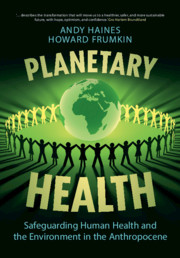Book contents
- Planetary Health
- Reviews
- Planetary Health
- Copyright page
- Contents
- Preface
- Acknowledgements
- 1 Our Changing Planet
- 2 Climate Change
- 3 Pollution, Land Use, Biodiversity, and Health
- 4 Assessing Vulnerability and Risk in the Anthropocene Epoch
- 5 Adaptation and Resilience to Planetary Change
- 6 Addressing Conceptual, Knowledge, and Implementation Challenges
- 7 Health in the Sustainable Development Goals
- 8 Transforming Energy and Industry: Towards a Net-Zero Circular Economy for Health
- 9 Sustaining Urban Health in the Anthropocene Epoch
- 10 Food Systems and Land Use
- 11 The Role of Health Professionals in Fostering Planetary Health
- 12 Sustaining Planetary Health in the Anthropocene
- Index
- References
10 - Food Systems and Land Use
Published online by Cambridge University Press: 01 July 2021
- Planetary Health
- Reviews
- Planetary Health
- Copyright page
- Contents
- Preface
- Acknowledgements
- 1 Our Changing Planet
- 2 Climate Change
- 3 Pollution, Land Use, Biodiversity, and Health
- 4 Assessing Vulnerability and Risk in the Anthropocene Epoch
- 5 Adaptation and Resilience to Planetary Change
- 6 Addressing Conceptual, Knowledge, and Implementation Challenges
- 7 Health in the Sustainable Development Goals
- 8 Transforming Energy and Industry: Towards a Net-Zero Circular Economy for Health
- 9 Sustaining Urban Health in the Anthropocene Epoch
- 10 Food Systems and Land Use
- 11 The Role of Health Professionals in Fostering Planetary Health
- 12 Sustaining Planetary Health in the Anthropocene
- Index
- References
Summary
Providing equitable access to nutritious and affordable food for a growing world population in the face of multiple environmental changes is one of the greatest challenges facing humanity. Despite steep increases in agricultural yields beginning in the mid-twentieth century, the global food system is failing to provide nutritious food for much of the world’s population. The food system also imposes a heavy burden on Earth systems; it is a major driver of land use change, biodiversity loss, freshwater depletion, air and water pollution and climate change, as outlined in Chapters 1–3. Current food systems are also grossly inefficient, with, for example, overuse of nitrogen and phosphorus in some regions and underuse in others, together with high levels of food loss and waste, such that about 30% of food produced is never eaten (1). This chapter focuses on potential strategies to improve nutrition and health while reducing the environmental footprint of food systems, with the aim of staying within planetary boundaries.
- Type
- Chapter
- Information
- Planetary HealthSafeguarding Human Health and the Environment in the Anthropocene, pp. 310 - 359Publisher: Cambridge University PressPrint publication year: 2021



